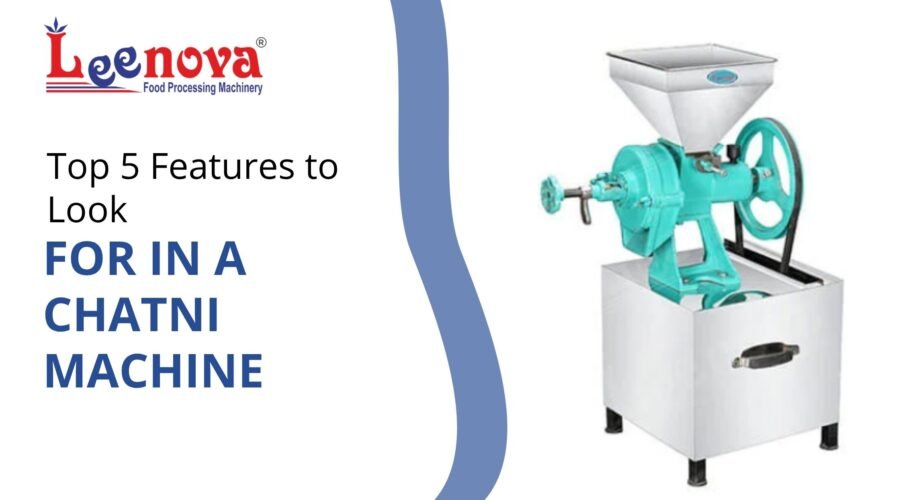In Indian kitchens, chutney is never just a side. It’s an emotion, an accent that elevates every meal—from street-side samosas to five-star dosas. But when it comes to preparing chatni in commercial or industrial kitchens, too many setups still rely on makeshift blenders, mixer grinders, or repurposed wet grinders. The result? Inconsistent texture, overheated output, and frequent breakdowns.
For food businesses, that won’t cut it. You need a dedicated chatni machine designed for volume, hygiene, consistency, and taste. Whether you’re running a cloud kitchen, a catering service, or a food processing unit, the right machine isn’t a luxury—it’s your ticket to scalable flavor.
Feature #1: Blade Design that Respects Texture and Tradition
Not all blades are created equal. While many machines boast “sharp stainless steel blades,” the real magic is in their geometry. Chutneys are delicate emulsions that require not just cutting, but also crushing, blending, and grinding to achieve the right micro-texture. A good chatni machine should feature multi-angle blades that replicate the stone-ground feel while maintaining uniformity.
Look for machines with:
- Curved or hammer-type blades
- Low RPM but high torque operation
- No blunt chipping that alters taste or aroma
Leenova’s chatni machines, for instance, are engineered to keep the original mouthfeel of coconut, coriander, or garlic chutneys—minus the elbow grease.
Feature #2: Motor Power That Handles Real Ingredients (Not Just Tomatoes)
A lot of budget machines can make tomato puree. But will they grind tamarind pulp, roasted dal, ginger, and frozen coconut chunks? Commercial chutney-making demands motor durability and torque more than just wattage. You need a machine that doesn’t stutter when it meets fiber, spice, or raw hardness.
Ideal motor characteristics include:
- Minimum 1HP motor for medium scale
- Continuous duty cycle (S1 class or equivalent)
- Overload protection and thermal cutoff
Leenova ensures its motors are industrial-grade, built for kitchens that can’t afford downtime. Because the only thing that should be burning in your kitchen is the mustard seeds.
Feature #3: Hygiene-First Construction for Commercial Use
In commercial food prep, hygiene isn’t optional—it’s survival. A chatni machine should be built for easy cleaning, quick disassembly, and full stainless-steel contact parts. Any crevice, gasket, or screw that traps masala is a microbial party waiting to happen.
Key hygiene features to prioritize:
- Food-grade SS 304 construction
- Smooth welds and no dead corners
- Easy-to-remove jars and blades
- Sealed motors to prevent ingress of water
Leenova’s machines prioritize cleanability with open access designs and minimal manual labor needed for maintenance. When every batch matters, so does every wash cycle.
Feature #4: Easy Discharge and Zero-Waste Handling
Most standard grinders require you to tilt, scoop, or scrape out the chutney. That means loss of product, inconsistent portioning, and worker fatigue. A modern chatni machine should allow for:
- Bottom-side discharge or tap-based flow
- Tilting jar with lock and lift handle
- Zero dead-zone interiors to avoid material getting stuck
This not only reduces wastage but speeds up batch production and reduces spillage. For high-volume kitchens, even a 5% yield improvement adds up over time—in rupees and reputation.
Feature #5: Scalable Capacity with Consistent Output
Whether you’re making 5 kg or 50 kg per day, your chatni machine should offer scalability without sacrificing quality. A common mistake is upsizing to a larger unit and realizing it doesn’t blend as evenly. Look for machines with proportional design scaling—where blade design, motor torque, and drum geometry grow together.
Ask yourself:
- Is this machine available in multiple capacities?
- Will my chutney taste the same in 10L as it does in 2L?
- Is the machine future-proof for growing demand?
At Leenova, every capacity upgrade comes with recalibrated design. That means your mint chutney stays minty—even when your orders double.
Bonus Feature: Why Local Service and Parts Availability Matters
You’re not just buying a machine—you’re marrying it. And like any long-term relationship, things might break, overheat, or need a tune-up. This is where local support becomes priceless.
Choose a brand with:
- Local service centers or distributor tie-ups
- Readily available spares
- Responsive technical support
Leenova’s wide dealer network across India means your downtime stays minimal and your chutney keeps flowing—from Ahmedabad to Agartala.
Conclusion: When Every Batch Tastes Like the First — That’s the Right Machine
Dozens of machines can make something that looks like chutney. But the right chatni machine makes it feel like it was made in your grandmother’s kitchen. Every batch is consistent. Every texture is just right. Every ingredient is respected.
And that’s what the food business is about—taste at scale.
So if you’re serious about flavor, consistency, and customer trust, don’t settle for repurposed mixers. Invest in a chatni machine that’s purpose-built, professionally supported, and proudly made for Indian kitchens.
At Leenova, we don’t just make machines. We make flavor scalable.


